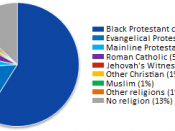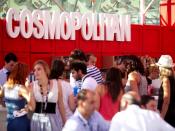Cosmopolitan Magazine's notoriety is mostly based upon displaying the "most beautiful" women in the world. This magazine gives young women a standard of beauty to strive for, although it is realistically unattainable. Therefore, it was chosen as the site of study due to it's popularity and provision of the hegemonic notions of what is beautiful. Looking through the October and November issues of Cosmopolitan magazine, over 150 advertisements were found. Most were for makeup and fragrances, featuring white women in every single one, almost interchangeably. The body type and bone structure of these women made them look as though they share the same gene pool. Out of the approximate 150 advertisements, eleven featured an African-American woman in the photographs. This portion of the assignment uncovers the reality that Black women are oppressed in that they are not allowed an opportunity to even be featured in the hegemonic ideologies of "true" beauty.
The two images using Black women to sell makeup and hair products featured well-known celebrities/sex symbols. Opposed to the no-name models used in advertising campaigns for such cosmetic heavyweights as Maybelline, Cover Girl, and Max Factor. Halle Berry is a representative for Revlon, which may not have been the case if her features were not so characteristically Caucasian. Although this is partially due to her mother being White, Revlon uses Halle as a sort of disclaimer to being centered around White standards of beauty. Yet Halle is able to wear shades of makeup made for White skin to begin with. The other ad features Beyonce Knowles, lead singer of Destiny's Child. Her light complexion and high cheekbones allow her to model for a company that uses all White models - L'Oreal. Only in the advertisement for hair dye (not makeup or skin products) does L'Oreal feature an African-American...


